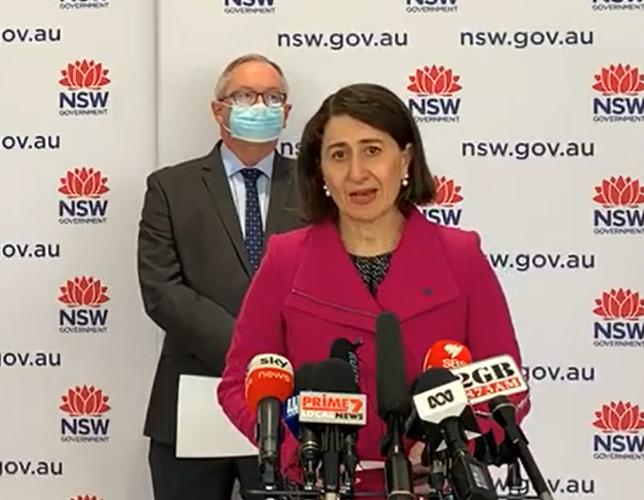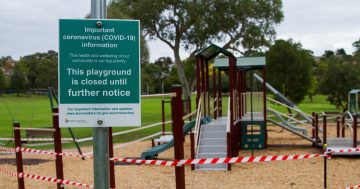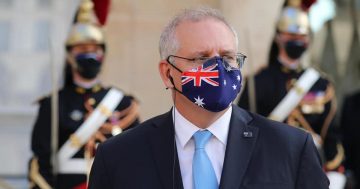
NSW Premier Gladys Berejiklian talks to the media: still spinning away her disastrous COVID response.
The worst possible place to have the weakest link in Australia’s COVID-19 chain of defence would have to be Sydney, and yet here we are.
In past times there may have been mass resignations for such an obvious stuff-up, but these days all we get is more spin and more deflection.
Seven weeks into the Sydney, and now regional NSW and ACT outbreak, and the panic button has finally been pushed.
Chief Minister Andrew Barr, who has had plenty of opportunities to put the boot in but remains diplomatic, welcomed the state-wide lockdown and ramping up of restrictions, only lamenting that it hadn’t come all those weeks ago.
But NSW Premier Gladys Berejiklian was determined to do things her way, despite the experience elsewhere in the country or world for that matter.
No ring of steel, no uniform lockdown to prevent the virus from spreading across Sydney or leaking to the regions.
Go early, go hard – that was the way forward if you didn’t want to end up in a long, exhausting and protracted battle against the virus.
But as the other states and territories looked on in horror and the Prime Minister once again sniffed the populist breeze rather than show any real leadership, the slow-moving train crash unfolded in its own inevitable way.
It’s Delta, this is different, said Gladys. The old rules no longer apply. Despite the experts saying you needed to go even harder, precisely because Delta is more transmissible and affects a wider range of age groups.
When the disaster became apparent, the Premier was still blaming Delta, saying that was why the response was not working, along with hectoring the south-west of Sydney for their large families and connected households.
It’s now clear Gladys was just not listening to the health advice, that Chief Health Officer Kerry Chant had been sidelined as other interests got into the Premier’s ear.
This juggling of these economic and political interests while the virus spread relentlessly wasted precious time until there was nothing more for it but to go to the full crackdown.
By then, the virus was well and truly out of control.
The Sydney experience has exposed the lie of us all being in this together, and the socio-economic fault lines not just across Sydney but across the nation as story after story emerges of the exemptions and the exceptions for those with the bank accounts, the properties or so-called essential skills or businesses to step outside the restrictions.
The NSW Government’s approach has divided Sydneysiders, dismayed the other states and territories, cost lives and put more lives and livelihoods at risk.
Even now, Gladys is still spinning a better future when the city gets to not just the 70 per cent vaccination rate set by Scott Morrison but as low as 50 per cent, even suggesting the vaccinated will win special privileges.
Modelling by the Doherty Institute indicates that even a 70 per cent vaccination rate, with daily cases in their hundreds like now, will still mean 385,000 cases and 1,500 deaths in NSW could happen in a six-month period.
That’s what living with the virus means.
The NSW leadership should pay politically for this mess, but this is where we are, and governments everywhere have to deal with what’s in front of them.
Mr Barr was asked only last week what would it take for the ACT to go into lockdown. His answer was just one case, pointing out how many people could be affected by a single person.
He was as good as his word, and whatever else you might think about the Chief Minister, he has taken the health advice, acted decisively with clear voice and mind and taken the people of Canberra with him.
The very antithesis of the half-hearted approach that has only elicited a likewise response from the many people in Sydney who won’t stay home, spurn social distancing and masks, and resent their entitled lives being interrupted.
As we all know, lockdown was never meant to be a continuous feature of managing the pandemic but was there to buy time while vaccines were developed or the virus petered out.
The Federal Government’s vaccine procurement mistakes and slow rollout squandered that opportunity.
The job now is to slow the virus’s spread and accelerate the supply and delivery of vaccines to provide as much protection as possible.
If there is one lesson from the NSW fiasco, it’s that in crises such as these, governments and leaders need to ignore the politics and vested interests, forget the spin and be upfront with the public about what is at stake.
COVID-19 won’t be the last threat to our well-being. Governments of all colours will have to confront multiple environmental issues and their fallout, not to mention the existential crisis that hangs over the planet in the shape of global warming.
They cannot be ignored with wishful thinking, political accommodation, or putting them in the too hard basket.
Time, like in Sydney, is not on our side.














